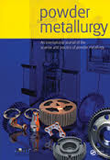
POWDER METALLURGY
Scope & Guideline
Shaping the Future of Ceramics and Composites
Introduction
Aims and Scopes
- Additive Manufacturing and Powder Processing:
The journal emphasizes research on various additive manufacturing techniques, particularly those involving powders, such as binder jetting and metal injection molding. This includes studies on the properties and performance of materials produced through these methods. - Microstructural Analysis and Material Properties:
A significant focus is placed on understanding the microstructural evolution of materials processed by powder metallurgy. This includes examining the mechanical properties of sintered components and the effects of various processing parameters. - Sustainability in Powder Metallurgy:
The journal addresses sustainability issues related to powder metallurgy, including the development of eco-friendly materials and processes, as well as the incorporation of recycled materials in powder formulations. - Technological Innovations and Trends:
Research on the latest technological advancements in powder metallurgy, including new techniques, equipment, and methodologies for improving production efficiency and material performance. - Industry Applications and Case Studies:
The journal frequently publishes case studies and reports that highlight practical applications of powder metallurgy in various industries, showcasing real-world implementations and their outcomes.
Trending and Emerging
- Sustainability Initiatives:
There is a growing emphasis on sustainability within the powder metallurgy sector, with research focusing on eco-friendly practices, the use of recycled materials, and the development of sustainable alloys. - Integration of Artificial Intelligence:
The application of artificial intelligence in the design, optimization, and characterization of powder metallurgy processes is on the rise, indicating a trend towards leveraging advanced technology to enhance manufacturing efficiency. - Advanced Characterization Techniques:
Emerging themes include the use of advanced characterization methods, such as quantitative metallography and fractography, to better understand the performance and reliability of powder metallurgy components. - Research on Composite Materials:
There is an increasing interest in the development and application of composite materials within powder metallurgy, reflecting a trend towards creating materials with tailored properties for specific applications. - Fatigue and Mechanical Performance Studies:
Recent publications have emphasized the investigation of fatigue performance and mechanical properties of sintered materials, particularly in relation to their applications in demanding environments.
Declining or Waning
- Traditional Powder Metallurgy Techniques:
There is a noticeable reduction in research focused on traditional techniques such as conventional sintering and powder pressing, as the field increasingly shifts towards innovative methods like additive manufacturing. - Basic Theoretical Studies:
The journal has seen fewer publications dedicated to fundamental theoretical studies of powder metallurgy processes, with a growing preference for applied research that demonstrates practical applications and outcomes. - Single-Material Studies:
Research focusing solely on single-material systems is declining, as there is an increasing interest in multi-material and composite systems that offer enhanced properties and functionalities.
Similar Journals
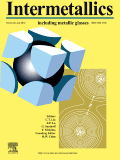
INTERMETALLICS
Elevating Knowledge in Materials Science and MechanicsINTERMETALLICS, a prestigious journal published by ELSEVIER SCI LTD in the United Kingdom, has been a vital resource in the fields of Materials Science, Mechanical Engineering, and Chemistry since its inception in 1993. Renowned for its rigorous peer-review process and commitment to high-quality research, this journal enjoys an impressive position within the top quartile (Q1) rankings of its categories, signifying its influence and esteem in the academic community. With a particular emphasis on the study of intermetallic compounds and their applications, INTERMETALLICS attracts groundbreaking research and innovative contributions that push the boundaries of knowledge in metals and alloys, as well as mechanics of materials. Researchers looking for a platform to disseminate cutting-edge findings will find this journal an exemplary choice, further enhanced by its commendable Scopus rankings that illustrate its widespread recognition and relevance. Though it does not currently offer Open Access options, the journal remains committed to advancing the field through selective publication of impactful research, making it an essential reference for researchers, professionals, and students alike interested in the dynamic interplay between materials and engineering.

STEEL RESEARCH INTERNATIONAL
Unveiling the Science Behind Steel and Alloys.STEEL RESEARCH INTERNATIONAL, published by WILEY-V C H VERLAG GMBH, is a premier journal that serves as a vital source of knowledge in the fields of condensed matter physics, materials chemistry, and metal and alloy research. With an ISSN of 1611-3683 and an E-ISSN of 1869-344X, this journal provides open access options that enhance its visibility and accessibility. Recognized for its scientific merit, it currently holds a Q2 ranking across multiple categories including Condensed Matter Physics and Materials Chemistry. This translates to an exceptional placement within the 64th percentile for Metals and Alloys and substantial recognition in other related fields according to Scopus rankings. By bridging theoretical concepts and practical applications, STEEL RESEARCH INTERNATIONAL aims to foster innovative research and dissemination of knowledge among researchers, professionals, and students focused on advancing the metallurgy and materials science domains. With a commitment to remain at the forefront of research from 2003 to 2024, the journal is poised to continue shaping the future of steel and alloy studies.
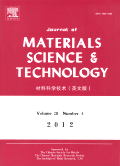
Journal of Materials Science & Technology
Fostering Collaboration in Cutting-edge Material ResearchThe Journal of Materials Science & Technology, published by JOURNAL MATER SCI TECHNOL in China, is a leading forum for the latest research in the multidisciplinary field of materials science. With the ISSN 1005-0302 and E-ISSN 1941-1162, this esteemed journal boasts an impressive impact factor and has established itself as a vital resource for professionals, researchers, and students alike. Covering a wide range of topics, including ceramics, composites, materials chemistry, mechanical engineering, and polymers, it has achieved a coveted Q1 ranking in multiple categories as of 2023, reflecting its position in the top tier of scholarly publications. Notably, the journal excels in its Scopus ranks, placing within the top 5% in categories such as Metals and Alloys and Mechanical Engineering. Aiming to foster knowledge and innovation in material development and application, the journal is committed to facilitating groundbreaking research and collaborations that propel the field forward. With its convergence of insights from 1993 to 2025, the Journal of Materials Science & Technology remains an indispensable resource for the advancement of materials science.

POWDER TECHNOLOGY
Pioneering Developments in Chemical EngineeringPOWDER TECHNOLOGY is a prestigious journal published by Elsevier, focusing on the vital field of powder technology within chemical engineering. With an impressive impact factor and ranked in the top percentile (88th) of Scopus, this journal has secured its position as a leading resource, classified in the Q1 category of Chemical Engineering (miscellaneous). The journal brings together groundbreaking research and innovative developments in powder processing, characterization, and application, making it an essential publication for researchers, professionals, and students interested in advancing knowledge and practices in this dynamic field. Established in 1967 and continuously evolving with a scope that encompasses the intersection of material science and engineering processes, POWDER TECHNOLOGY embodies a commitment to fostering scientific inquiry and sharing knowledge. Researchers can access relevant articles through a comprehensive platform, ensuring timely dissemination of findings that are critical for both academia and industry.
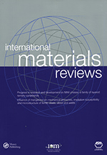
INTERNATIONAL MATERIALS REVIEWS
Exploring the Frontiers of Materials ScienceINTERNATIONAL MATERIALS REVIEWS, published by SAGE Publications Inc, is a leading journal dedicated to the comprehensive analysis of contemporary research in the fields of materials chemistry, mechanical engineering, mechanics of materials, and the study of metals and alloys. With an impressive impact factor and a Q1 ranking across multiple categories such as Materials Chemistry and Mechanical Engineering in 2023, it ranks amongst the top journals for innovative materials research. The journal has a long-standing history since its inception in 1987 and continues to serve as a crucial resource for academics and professionals alike. Although it is not open access, it is renowned for its rigorous peer-review process and its commitment to disseminating high-quality materials science research globally. Researchers, students, and industry professionals benefit greatly from the journal's insightful reviews, both for the advancement of theoretical knowledge and practical applications within the fast-evolving materials field.
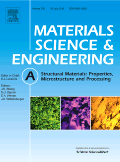
MATERIALS SCIENCE AND ENGINEERING A-STRUCTURAL MATERIALS PROPERTIES MICROSTRUCTURE AND PROCESSING
Advancing the Frontiers of Materials ScienceMATERIALS SCIENCE AND ENGINEERING A-STRUCTURAL MATERIALS PROPERTIES MICROSTRUCTURE AND PROCESSING, published by ELSEVIER SCIENCE SA, is a highly regarded journal specializing in the fundamental and applied aspects of materials science. Since its inception in 1988, this journal has established itself as a leading platform for disseminating innovative research findings, particularly focused on structural materials, their properties, microstructure, and processing techniques. With a prominent impact in the field, it ranks in the Q1 category across several disciplines including Condensed Matter Physics, Materials Science, Mechanical Engineering, and Nanoscience and Nanotechnology, highlighting its significance and influence within the academic community. The journal is accessible to a global audience of researchers, professionals, and students, underscoring its commitment to advancing knowledge in materials engineering. Aspiring authors and readers will find this journal an essential resource for cutting-edge research and the latest advancements in the field, further supported by its impressive Scopus rankings that place it among the top-tier publications.
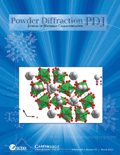
POWDER DIFFRACTION
Transforming Material Science with Cutting-Edge Diffraction InsightsPOWDER DIFFRACTION, published by Cambridge University Press, is a pivotal journal focused on the evolving field of powder diffraction, which is crucial for researchers in condensed matter physics, materials science, and radiation studies. Established in 1986, this journal emphasizes the latest methodological advancements and applications in powder diffraction techniques, making it a comprehensive resource for professionals and students alike. With an ISSN of 0885-7156 and an E-ISSN of 1945-7413, it offers valuable insights into the characterizations of crystalline materials. Although currently not open access, the journal is highly regarded for maintaining rigorous peer review standards, reflecting in its rankings within the lower quartiles of relevant fields according to Scopus. Positioned within the United States and with distribution through Cambridge University Press, POWDER DIFFRACTION aims to foster innovation and knowledge exchange among the global scientific community, thereby solidifying its role as an essential platform for disseminating research findings from 1986 through to 2024 and beyond.
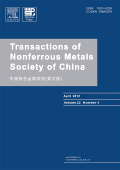
TRANSACTIONS OF NONFERROUS METALS SOCIETY OF CHINA
Fostering excellence in materials science and engineering.TRANSACTIONS OF NONFERROUS METALS SOCIETY OF CHINA, published by Elsevier, is a premier academic journal that serves as a vital platform for researchers and professionals specializing in materials science, condensed matter physics, geotechnical engineering, and engineering geology. Established in 1994, this esteemed publication has maintained a robust focus on the latest developments in the nonferrous metals sector, reflecting its significant impact in the field with a Q1 categorization across multiple disciplines. With impressive Scopus rankings—placing it in the top 20% of journals in relevant categories—this journal is recognized for its quality and rigor, providing critical insights into metals and alloys, materials chemistry, and their applications. The non-open access format ensures a dedicated readership among professionals and academics seeking substantial and authoritative research articles. By fostering knowledge exchange, the journal strives to advance the understanding and application of nonferrous metals, making it an essential resource for anyone involved in material innovations and engineering solutions.

JOURNAL OF MATERIALS ENGINEERING AND PERFORMANCE
Innovating for Tomorrow's Engineering ChallengesJOURNAL OF MATERIALS ENGINEERING AND PERFORMANCE, published by Springer, serves as a vital resource for researchers and professionals in the fields of materials science, mechanical engineering, and mechanics of materials. With an ISSN of 1059-9495 and E-ISSN of 1544-1024, this journal boasts a commendable track record since its inception in 1992 and is set to continue providing valuable insights until 2024. Positioned in the Q2 quartile of its categories, the journal is ranked #246 in Mechanical Engineering and #168 in Mechanics of Materials according to Scopus, reflecting its commitment to high-quality research. While currently not adopting an open access model, it remains accessible to academic professionals and students eager to advance their knowledge in the rapidly evolving domain of materials engineering. The scope encompasses innovative research focused on material performance, engineering applications, and technological advancements, making it an indispensable tool for those at the forefront of the field.

INTERNATIONAL JOURNAL OF POWDER METALLURGY
Advancing Powder Metallurgy for a Sustainable FutureInternational Journal of Powder Metallurgy, published by the American Powder Metallurgy Institute, is a prestigious periodical dedicated to advancing the field of powder metallurgy and its applications in various engineering disciplines. With its ISSN 0888-7462, this journal has roots tracing back to 1969, showcasing a wealth of research and innovations up to 2022. Although it currently ranks in the fourth quartile in both Industrial and Manufacturing Engineering and Metals and Alloys categories, it serves as a vital platform for sharing new findings, technical advancements, and discussions in powder metallurgy. Despite not being an open access journal, it remains an important resource for researchers, professionals, and students striving to deepen their understanding and expertise within this niche field. The journal’s content not only reflects the ongoing trends in materials science but also encourages interdisciplinary collaboration, making it an essential read for anyone involved in the study and application of powder metallurgy.